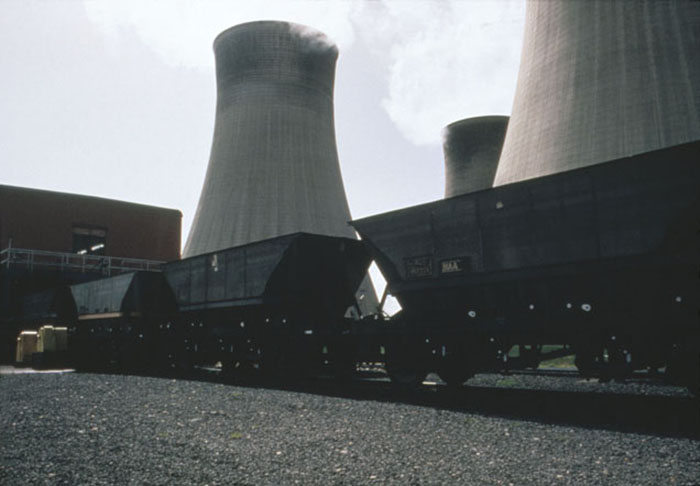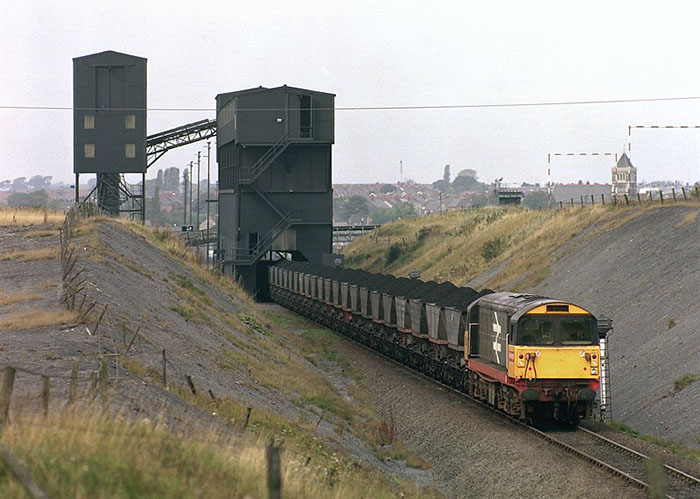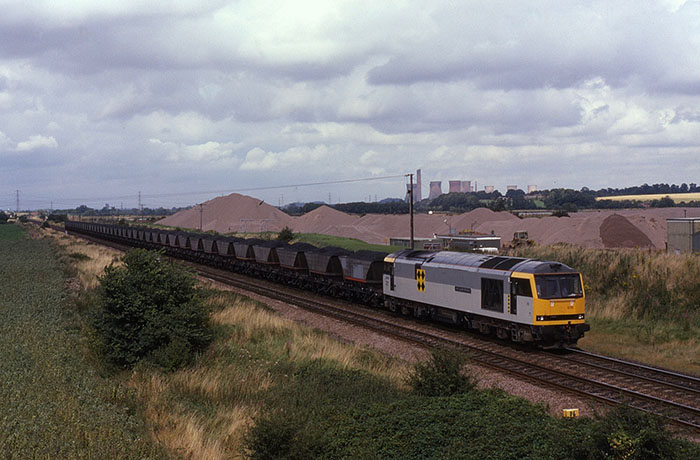

 STUART JORDAN looks at the this streamlined method of coal transportation.
STUART JORDAN looks at the this streamlined method of coal transportation.
Coal mines across Britain would have extensive sidings to hold wagons. Loaded wagons would be held as buffer stocks in case there were fluctuations in demand at power stations. Although this was useful, it was not economical, as it tied up many coal wagons to hold the surplus stock.

Merry Go Round at Cottam Power Station.
This inefficiency was highlighted in the infamous Beeching Report Reshaping Britain’s Railways in 1963. The objective was to streamline the movement of coal by rail, focussing on long distance coal trains rather than the shorter branch lines that were also likely to feel the Beeching Axe. The solution proposed was the Merry-Go-Round (MGR) system, which would work at ports and collieries as well as at the power stations themselves.
The British Railways Board (BRB), in collaboration with the Central Electricity Generating Board (CEGB) and the National Coal Board (NCB), developed the method, which would see permanently coupled rakes of wagons that would be loaded and unloaded without stopping, or being uncoupled from their locomotive. The diesel locomotives were fitted with a new electronic speed control called, simply, Slow Speed Control, which allowed the locomotive to run at 0.5mph. This meant that the newly designed MGR wagons could be filled from above at the ports and collieries, and then would unload into a tip underneath when they reached the power station. The train would then head off to pick up more coal.

1986. The rapid loader at Ellistown, Leicestershire fills a merry-go-round train pulled by a Class 58.
The MGR method led to a much more streamlined and economical service, with locomotives and rolling stock no longer waiting idle to be loaded or unloaded manually. At the power station, a device that was nicknamed a ‘dalek’ automatically opened and closed the bottom door of the wagon. With trains continuously moving through the loading/unloading stages, it eliminated the need for complex track and large marshalling yards or sidings. These could then be demolished, reducing traffic and congestion around connections with the mainline.
True MGR operation rarely existed however, as only a few power stations (e.g. Ratcliffe, West Burton, Cottam) had balloon loops of track allowing continuous movement. Most still required the locomotive to be detached and shunted to the other end of the train to haul it away. In the late 1980s, the shortest MGR route was only three miles, but nationwide the average was 30 miles. Trains would generally consist of between 30 and 48 wagons, depending on the route.

1993. A Railfreight Coal Sector Class 60 pulls a MGR train past Egginton in Derbyshire.
The first MGR services began in 1965, with testing carried out on the route between Manston colliery and West Burton power station. The first power station to officially receive coal by MGR was Cockenzie in East Lothian the year after. The 80 MGR wagons used to feed Cockenzie was estimated to have removed 1500 conventional coal wagons from the network.
Over 11,000 MGR Hoppers were built, with the prototypes put together at Darlington and the rest built in batches at Shildon works (with one batch of 160 built at Ashford). This new wagon was fitted with air-brakes and had a capacity of 33 tonnes. It had the code HOP AB 33 (Hopper Air Brake 33 tonne). With the introduction of the Total Operation Processing System (TOPS) into BR in 1973, the hopper was given the classification code ‘HAA’. Different classifications were added as the hoppers were modified.
| HAA | Original 1964 design |
| HBA | Canopy added |
| HCA | Canopy added |
| HDA | The final batch built in 1982 |
| HFA | Aerodynamic canopy added |
| HMA | Modified brakes |
| HNA | Modified brakes and canopy |
Privatised Variants
| HTA | (EWS) Increased tonnage and air-operated doors |
| HYA | (GBRf) Increased tonnage and air-operated doors |
| HHA | (Freightliner) Increased tonnage and air-operated doors |
| HXA | (Freightliner) Increased tonnage and air-operated doors |
| IIA | (Jarvis Fastline) Increased tonnage and air-operated doors |
The privatisation codes that are listed above all have air-operated doors, rendering the daleks obsolete.
As previously mentioned, locomotives used on a Merry-Go-Round route would have to be fitted with the Slow Speed Control system. The driver engages the SSC and it regulates the speed to 0.5mph while loading and unloading. The system was fitted to some Class 20s, 26s, 37s, and 47s as required. All members of classes 56, 58, 59, 60, and 66 were fitted with SSCs, with it being added and removed from all Class 50s due to non-use.
As previously mentioned, many small branch lines to collieries were closed in the cuts after 1963. These closures exacerbated the decline of the British coal industry as production declined and many smaller pits closed without the infrastructure available. Coal consumption had also decreased, which meant in hindsight it was correct to swich to a more economical method of transporting coal to stop BR making substantial losses.
The overall decline of the coal industry made many of the MGR wagons redundant. In 2001 EWS introduced a new batch (HTA) which replaced many of the original HAA wagons, which were completely removed from the network by 2010. Many of them avoided scrapping by being rebuilt as MHA lowsided spoil wagons, CDA china clay hoppers, and MSA scrap hoppers. Several HAAs have survived into preservation.